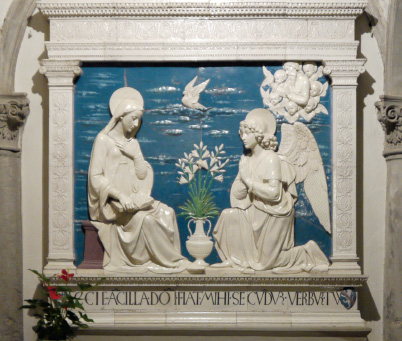![]()
THE religious have always been drawn to remote places, and the visitor to Tuscany should try to see some of the monasteries that made so important a contribution to spiritual life. South-east of Florence, on the flank of the Pratomagno, is Vallombrosa, which gave its name to the monastic order instituted by San Giovanni Gualberto and haunted the imagination of Milton. Across the hills to the east is Camaldoli, where the order of that name was founded by Saint Romuald. Further south is La Verna, then a wild fastness, to which Saint Francis withdrew in the company of Fra Elia (Brother Elias), who witnessed his stigmatization there on 17 September 1224.
The main approaches from Bibbiena and Pieve Santo Stefano climb steeply, for the mountain is 1,283 metres high. It takes its name from the dense woodland that crowns the Monte Penna. Inevitably La Verna became a place of pilgrimage, and this it very much remains, with a cluster of small buildings often crowded with the devout.
The visitor now enters through an arch and follows a passage, eventually arriving in the irregular central court by the main church. Cross this to the modest gate to which pilgrims formerly climbed. Their first sight on entering, ahead and to the right, was the small church of Santa Maria degli Angeli, first built in 1216–18 by Count Orlando dei Cattani, who had given the mountain to Saint Francis. The interior is subdivided by lateral altars with polychrome glazed terracotta reliefs by Giovanni della Robbia that contrast with the restrained tonality of Andrea della Robbia’s main altarpiece of the Virgin entrusting her Girdle to Saint Thomas. To the right of the church is a corridor that leads to the small museum, with a handful of pictures and a collection of vestments. The processional route continued to the Chiesa Maggiore, begun in 1348. Nowhere perhaps is Andrea della Robbia, the gifted son of his father Luca, seen to better effect. The grandest of his reliefs in the church is the Ascension, but Andrea’s genius as a religious artist is more perfectly expressed in two ostensibly less ambitious compositions, the Adoration and the Annunciation, in both of which his disciplined palette, predominately of blue and white, is particularly successful.

Chiesa Maggiore: Andrea della Robbia, Annunciation, glazed terracotta.
From the chapel the pilgrim proceeds through the Corridor of the Stigmata to the small Chapel of the Stigmata dominated by the glazed altarpiece of the Crucifixion by Andrea della Robbia that has some claim to be his masterpiece. Certainly this is among the most compelling religious images of its time.
La Verna remains a place of rare beauty, not least in September when the woods are carpeted with pale pink cyclamen. It has, too, an unexpected magic when mist shrouds the unpretending buildings.